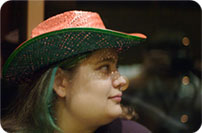technology, technique, & the brain
I’ve been reading lots of books lately on not only how humans consciously shape things, but on how things unconsciously shape us. Books like Our Own Devices, by Edward Tenner, and The Evolution of Useful Things, by Henry Petroski. While the former is a somewhat poorly written book that is more an amalgam of many facts than a manuscript, and the latter is a collection of wonderfully written if narrowly focused tales about objects, both have been affecting my thought processes and both have been very enjoyable. (To be honest, I’m really disappointed at the writing/editing quality of the Tenner book, because the facts are so interesting. Of all ironies, it’s a usability book that finds me having to stop, frequently, and rethink a sentence several times before I am sure what the author meant.)
<span id="more-3801"></span>
I also recently sat in on a 400-level human-computer interaction (HCI) class at the local university here. While I found that I already had a good familiarity with what was being taught, thanks to my reading, it was nevertheless stimulating to hear and see the reactions of students to these ideas, which were new to them, and which I had already accepted as truth.
So with these ideas percolating through my brain, I’ve gained a constant awareness, mindfulness of these effects that I didn’t really have before. I see examples everywhere. When you think about it, ordering doughnuts is a technique we all know, and if you didn’t know, it might be kind of difficult to start. You have to know that doughnuts are generally sold in dozens and half-dozens (otherwise, you pay out the nose), and that when you say “I’d like a dozen doughnuts, please,” the person working behind the counter will grab a box, some tissues, and then stand there, waiting for your instructions. “Two powdered, four glazed, two bavarian creme, and two marbled, please.” Oops, that was only ten. “Also, two chocolate glazed.”
We need to learn how to suck on baby bottles, tie our shoes (a much more complex movement than you’d think), how to avoid burning ourselves on hot things, how to put on shirts, how to button buttons and snap snaps, how to use velcro, how to adjust backpack straps, how to load a dishwasher, how to use a microwave, how to operate a vacuum, how to negotiate the many, many kinds of doorknobs and locks we encounter, how to drive a variety of vehicles, how to write checks and pay our taxes and play guitar (badly) or piano (well), how to use pushpins, how to clean, how to sing and hit the proper notes, how to impress our friends’ parents.
Sometimes the simplest things require more thought than we remember, and take more ingenuity and flexibility than we usually give ourselves credit for. Take locks and doors as one example. With my car, I usually lock it by smashing the “L” half of a rocker button on the driver’s side door, or tapping the lock button on the key fob while I walk away. But in my boyfriend’s car I must turn the key in the outside lock to the right—there’s no inside button to lock the car, and no keyless entry. In my old car, turning the key to the right would unlock it; on the door to my house, I turn the key in the deadbolt lock to the right, and the doorknob to the left. At my boyfriend’s apartment, I have to use a key card twice on two doors and then for his door, I have to turn the key upwards more than any other direction. At his parents’ place, one set of doors (of a total of five doors or double doors to the outside) locks only when you pull up on the long, graceful handle. At my father’s, his main door has only a simple brass knob, but set far below the normal height.
A single technology—a door—can be operated in many ways; people with arthritis or carpal tunnel often get rubber rings to put over round door knobs to help them grip with less pain; people with malformed or missing hands often require lever-based doorknobs instead; cats and dogs (and even small children!) can learn to operate doorknobs to get access to what they desire. Some door handles you twist—some you pull, or push on. Some have a button you depress to get what you want, others aren’t knobs or handles at all, but require you to insert a finger or two into a depression and pull on the door itself. For some doors, you have to push the door itself and go around in a circle—and if you slow down, you’ll get smacked by the rest of the door coming up behind. Some doors are big enough to walk through, others cover cabinets and little storage compartments. We still have this concept of “door,” but it encompasses such a crazy variety that it’s hard to believe we can still sit here and use the word “door” generically and be understood, and be sane.
The fact of the matter is, we’re always learning. We learn a lot about an awful lot of things we’d probably label “inane” or “stupid,” if we thought about them. These techniques are what get us through the day, not the technology. If a technique for handling various kinds of door knobs replaces the technique for tracking an animal through the woods, the fact still remains that we are technique- rather than technology-based creatures. While everything around us is really technology, it is the techniques that define their importance in our lives.
But we seem to constantly forget this fact, or never think about it in the first place; we equate progress with technology, and technology with tools. We don’t often stop to think about how strange it is that we are nearly naked, upright apes who crafted almost unfathomably complex machines to convey us around at ridiculous speeds.
We don’t often ponder the unique peculiarity of having doorknobs. The ultimate goal of user interface design is to create something that can also be so easily forgotten. Human interaction with technology has patterns, and interface designers need to expose and exploit those patterns. It’s not so much a question of design, but of discovering what the modern human brain expects, and delivering it.








I totally agree. I love doughnuts, but it’s always awkward to order them. The person at the counter stands their staring at you, or maybe looking upward in a bored manner. I still don’t know how to do it right.
And car doors…what’s with the ones where you have to hold the handle out to let the driver’s door stay locked, but you have to leave it in for the passenger doors? It’s like they punish you for learning one way to close the door. It’s an endless cycle.
Fortunately, people are thinking about these issues (a tiny bit) more these days.
Although there are cultural design differences, too. In Europe you barely ever see a modern door with a knob handle. They almost always use a lever-type handle (which is easier to use for the elderly and disabled).
So not only do people forget how they learned to use something that was designed well, but they also forget that something poorly designed could have been done better.
That’s awesome…
I think it would be usefull for other users also 🙁
Just thought I’d make a note about a problem…
But I’m not sure why!
I use Firefox in Ubuntu.
Thats correct.
I had and the fix I found 🙂
Good idea…
Thanks for the write-up…
Very nice write up 🙂